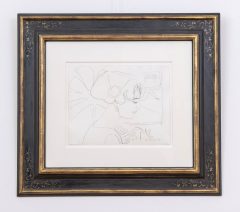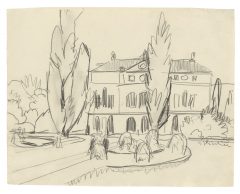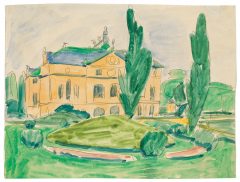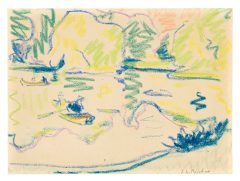Ernst Ludwig Kirchner
Kopf Dodo
ca. 1911
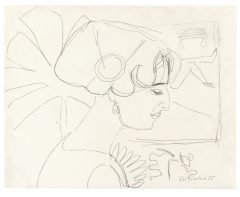
Pencil on vellum
27 × 33.4 cm / 10 5/8 × 13 1/8 in
Signed and dated »05«
The work has been registered by the Ernst Ludwig Kirchner Archiv Wichtrach/Bern
Stuttgarter Kunstkabinett R. N. Ketterer (1954); Private Collection Switzerland
- Sala de Exposiciones Fundación Eugenio Mendoza, "Expressionismo en Alemania", Caracas 1959
- Kunsthandlung Gauss/Kunsthalle Zürich/Galerie Ferdinand Möller/Kunstgebäude am Schlossplatz, "Ernst Ludwig Kirchner", München/Zürich/Köln/Stuttgart 1954
- "Expressionismo en Alemania", Ausst.-Kat., Caracas 1959, no. 40
- L. G. Buchheim, "Die Künstlergemeinschaft Brücke: Gemälde, Zeichnungen, Graphik, Plastik, Dokumente", Feldafing 1956, ill. 20
- Galerie Ferdinand Möller/Kunstgebäude am Schlossplatz, "Ernst Ludwig Kirchner", Ausst.-Kat, München/Zürich/Köln/Stuttgart 1954, no. 84
Ernst Ludwig Kirchner founded in 1905 together with Erich Heckel, Karl Schmidt-Rottluff and Fritz Bleyl one of the most influential groups of artists of the 20th century, the 'Brücke'. His Dresden studio is the meeting place of the German avant-garde. Drawing is a central element of artistic creation. Here the 'Brücke' painters practice the so-called 'Viertelstundenakt'.
Every 15 minutes the model changes poses. Now naturalistic studies are no longer the focus of interest. Rather, the draughtsmen practice a fast, reliable contour drawing in which the proportions and, above all, the expression are to be readable. The quick note of the perceived remains meaningful for Kirchner in all creative phases: I learned to appreciate the first litter, so that the first sketches and drawings were of great value to me. What have I often done to myself, to consciously complete on canvas what I had easily thrown down on the sketch in trance without any effort? 1 Kirchner always has his sketchbooks at hand and so countless drawings are created that can almost be read like a visual diary. The drawings are the actual focal point of his work, from which both painting and prints are derived.
Our drawing 'Kopf Dodo' from 1911 shows Kirchner's then girlfriend Dodo - Doris Grosse - in profile. 2 Dodo's surroundings remain unclear. The abstract green plant and the picture, however, could indicate that this is Kirchner's Dresden studio. He furnished it with self-designed decorations and carved sculptures modelled on primitive artists, as the collector Gustav Schiefler recalls: He had rented a strange studio in a suburban street in Dresden, obedient to need: a narrow grocery store that opened with a large window to the street and next to which a small chamber served as a bedroom. These rooms were fantastically furnished 3 The figure of Dodo in the foreground is drawn with certain lines. She keeps her eyes closed and her head is gracefully tilted forward. Despite the dynamic lines, the drawing emanates a great lightness and light-heartedness, which captivates the essence of the found mood and betrays it to the great expressionists.
1 Magdalena M. Moeller/Roland Scotti (Ed.), 'Ernst Ludwig Kirchner - Paintings, Watercolours, Drawings and Prints - An Exhibition on the 60th Anniversary of Death', Munich 1998, p. 12.
2 The encounter with Dodo is extraordinarily formative for Kirchner. Years after the separation he remembers his lover in a diary note of July 5, 1919: 'Your fine fresh lust for love, with you I experienced her completely, almost to the danger of my destiny. But you gave me the strength to speak about your beauty in the purest image of a woman.' See Nationalgalerie Berlin, 'Ernst Ludwig Kirchner', exhibition catalogue, Berlin 1980, p. 121.
3rd Magdalena M. Moeller (Ed.), 'From Dresden to Davos - Ernst Ludwig Kirchner Drawings', exhibition catalogue, Munich 2004, p. 72.
